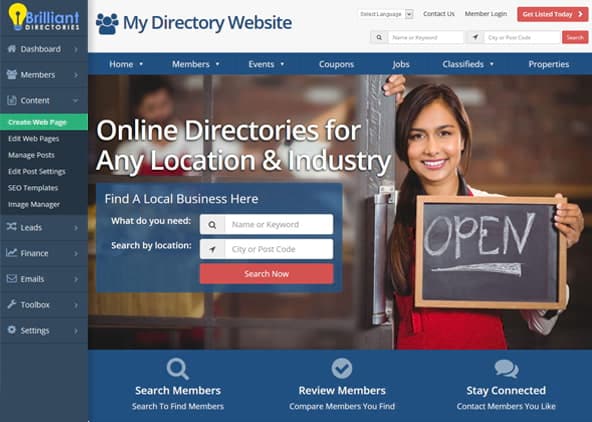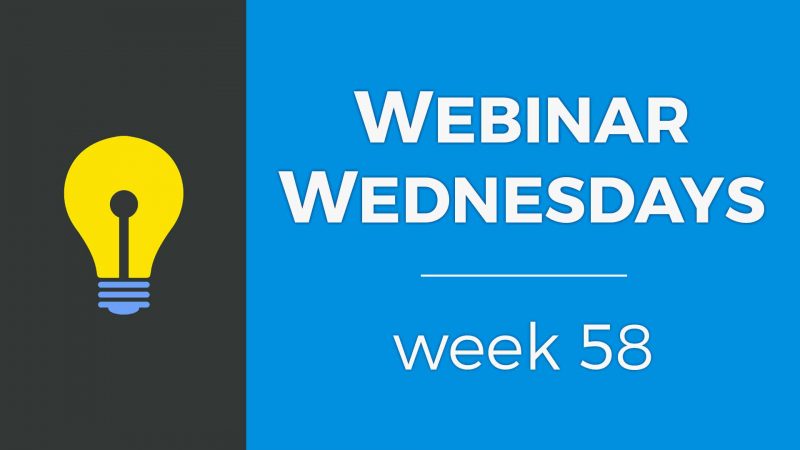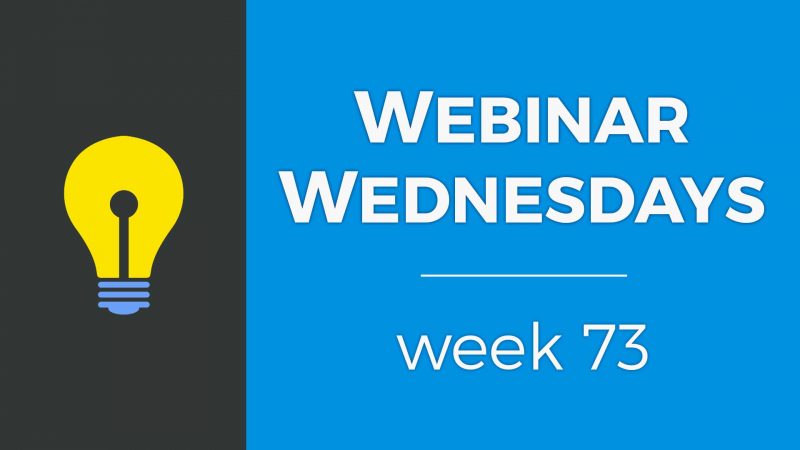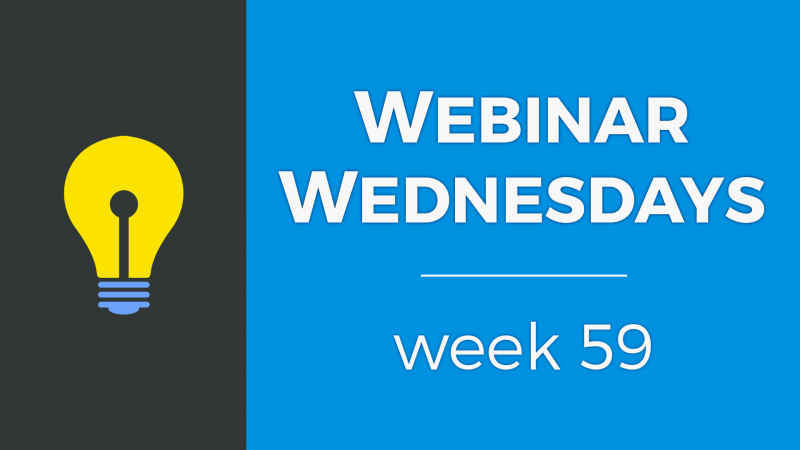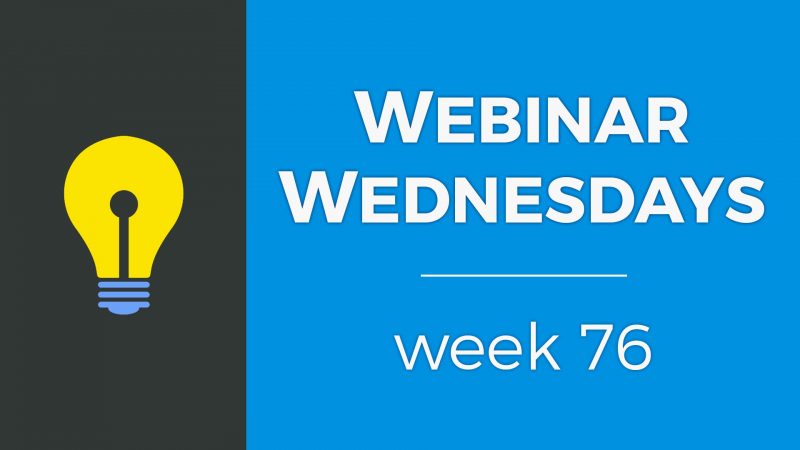
Key Topics:
- 2:27 – Search: “Require Complete Profiles”, Customize the required fields
- 7:11 – Design: Use Pre-Made Elements in Blog Posts
- 11:49 – Posts: Define Sidebar Position on Mobile Devices
- 14:30 – 2 New Add-Ons: File Upload for Forms & Member Credits System
- 15:09 – 3 Major Speed Updates: Form Validation, Google Maps & Dynamic Dropdowns
- 16:08 – Email Deliverability: Automated Domain Authentication for Sending Emails
- 17:12 – Feedback on the Require Complete Profiles update
- 18:58 – How to view members who have unsubscribed from your emails?
- 20:16 – 3 Elements You Should Add to Your Members’ Dashboards
- 20:45 – What’s So Special About the Dashboard Page?
- 22:48 – Key Elements to Add on the Dashboard
- 28:55 – Let’s See a Customized Member Dashboard
- 45:09 – How to add expiration/end dates to published posts? – How To Add Expire/End Dates To Multi-Photo Posts Such As Classifieds, Properties, Photo Albums & Products
- 48:28 – Suggestion to include filename/URL of posts with webhooks
- 49:25 – What happens to the images and other data of expired or unpublished posts?
- 51:51 – Which member profile elements can be included when checking if a profile is complete?
- 55:37 – What size should be used for banner images in the member dashboard?
- 57:36 – Suggestion to include post images in RSS feeds
- 58:25 – Suggestion for displaying expired/past posts (e.g., events) in post search results
New Features
Coming Very Soon
Tip of the Week
Questions & Answers

 AI-Generated Transcript – Please excuse any inaccuracies
AI-Generated Transcript – Please excuse any inaccuracies
Search: “Require Complete Profiles”, Customize the required fields (00:02:27)
- The “Require Complete Profiles” setting allows site administrators to require members to have complete profiles before their listings display in search results, which helps to prevent a bad user experience for visitors, and this setting can be found in the general settings area under search settings (00:03:13).
- Enabling this setting means that members must have a name, top-level category selected, profile photo or logo, and address entered in their profile to be considered complete and show up in search results (00:03:56).
- The setting now also allows for customization of the required fields, which can be done in the advanced settings by entering a comma-separated list of field names, and this can include default fields such as phone number, as well as custom fields like hair color (00:04:48).
- To determine the correct field names to include in the comma-separated list, site administrators can refer to the import template in the documentation, which includes a list of all possible field names that members can enter in their profiles (00:05:23).
- The customization of required fields works for both default and custom fields, and it allows site administrators to have more control over what information is required for members to have a complete profile and show up in search results (00:06:26).
- Some site administrators, including Teresa and Steven, are already using the “Require Complete Profiles” setting on their sites, and it is available for all site administrators to use (00:06:54).
Design: Use Pre-Made Elements in Blog Posts (00:07:11)
- Pre-made elements can now be used in blog posts, a feature that was previously available only in the admin dashboard area when creating web pages, and this update was requested from the Facebook group (00:07:13).
- To use pre-made elements in blog posts, users can toggle the “pre-made elements” button, which is a tealish-colored button, and add content blocks to their blog post, allowing them to quickly construct the page and insert elements such as calls to action (00:08:39).
- The pre-made elements available in blog posts are the same as those available in the admin backend area, and users can drag and drop these elements into their blog post, and then close the pre-made elements window, with the elements remaining in the blog post (00:09:41).
- The ability to use pre-made elements is not available for all post types, such as events, which is a post type meant for all members and the admin owner to create, and is mainly controlled by the form manager, where the admin can customize the form for posting and creating blog articles (00:10:29).
- In the form manager, the admin can edit the form for blog articles and see the pre-made elements option, which is available under the “fancy fields” section, and is designated for the admin, allowing them to include pre-made elements in their blog posts (00:10:47).
Posts: Define Sidebar Position on Mobile Devices (00:11:49)
- The search results page typically has a sidebar, which is usually located on the left side, and on mobile devices, the sidebar has historically been displayed at the end of the search results, but there is a new setting that allows users to decide if they want the sidebar to show above the results on mobile devices (00:11:50).
- This new setting can be useful for short sidebars with one to three elements, as it allows the sidebar to be displayed above the search results on mobile devices, but it may not be suitable for sidebars with many elements, as it could push the main search results further down the page (00:12:28).
- To access this setting, users can go to the “My Content” section, edit post settings, and look for the “Search Results Design” tab, where they can find the “Additional Settings” section and toggle open the settings to find the “Sidebar Position on Mobile Devices” option (00:13:05).
- The “Sidebar Position on Mobile Devices” setting is set to “Bottom” by default, but users can change it to “Top” to display the sidebar above the search results on mobile devices, and this setting can be applied to any post type, including events and digital products (00:13:30).
- It is recommended to use this setting only with short sidebars that have few elements, and it works best when only using the search module in the sidebar, without other elements, to avoid pushing the main search results too far down the page (00:13:57).
2 New Add-Ons: File Upload for Forms & Member Credits System (00:14:30)
- Two new add-ons, the file upload for forms and the member credits system, are nearing completion and are expected to be released soon, with a hoped-for release date in February or at the latest, early March (00:14:30).
- The development team is working to resolve some issues that have arisen, but the QA and development team is making progress in addressing these snags (00:14:53).
- Updates on the release of these add-ons will be provided in future webinars and in the Facebook group as soon as more information becomes available (00:15:02).
3 Major Speed Updates: Form Validation, Google Maps & Dynamic Dropdowns (00:15:09)
- There are three major speed updates in the final QA process that affect various parts of the software, and the QA team is thoroughly testing these updates before they are released (00:15:11).
- These speed updates involve form validation, Google Maps elements, and dynamic drop downs, which are currently loaded on every web page, but will only be loaded when requested in the future (00:15:27).
- The updates will improve page speed scores and reduce page load times by only loading elements such as form validation, Google Maps, and dynamic drop downs when someone clicks to edit or submit a form, or uses the dynamic drop downs (00:15:42).
- The new approach will load these elements only when they are needed, such as when someone wants to use the dynamic drop downs to select from a top-level category to a sub-level category (00:15:35).
- Once these updates are released, they are expected to increase page speed scores dramatically and reduce page load times, which will be a significant improvement (00:15:57).
Email Deliverability: Automated Domain Authentication for Sending Emails (00:16:08)
- Email deliverability is a major concern, and a system is being created to automate Integrated Windows Authentication for sending emails, which is expected to improve the likelihood of emails landing in inboxes rather than spam folders (00:16:09).
- The automation of the domain authentication process is intended to help most users, and additional steps will be provided for those who need to manually authenticate their domain by clicking a few buttons (00:16:16).
- The goal of automating domain authentication is to increase email deliverability, ensuring that more emails from the platform land successfully in people’s inboxes and fewer end up in spam folders (00:16:47).
- The release of the automated domain authentication system is anticipated to occur soon, and questions and comments about this update are being saved for the end of the webinar, although some questions may be addressed beforehand (00:16:57).
Feedback on the Require Complete Profiles update (00:17:12)
- Rich is appreciative of the new feature that requires complete profiles, as it has been a challenge to get members to complete their profiles, and anything that advances this cause is awesome (00:17:19).
- Rich has two questions on this topic: one is whether there is a way to view members who have not completed their profile, and the second is how these members will be notified or if there is a way for the member to be notified with auto reminders (00:17:30).
- A potential solution to this issue is to add a filter that allows searching members based on their completeness status, whether they’re completed or not, and then create a smart list of completed or incomplete profiles (00:18:11).
- With this filter, it might be possible to send an email to incomplete profiles on a regular basis, such as the first of every month, reminding them what they need to do to complete their profile in a light and friendly manner (00:18:40).
- Rich’s suggestion is considered a good one, and it is acknowledged that for now, the process of sending reminders to incomplete profiles might be a little manual, but it is a viable solution (00:18:50).
How to view members who have unsubscribed from your emails? (00:18:58)
- To view members who have unsubscribed from emails, users can navigate to the “contacts” section, then select “view contacts” and “view unsubscribe list” to see everyone who is part of the unsubscribe list (00:18:59).
- Members who are on the unsubscribe list will be omitted from email newsletters and other communications, even if they are included in smart lists (00:19:21).
- The unsubscribe list allows users to remove members from the list, manually add an email to the list, or simply view all members who have unsubscribed (00:19:34).
- Some users may unintentionally unsubscribe from emails by accidentally clicking on the unsubscribe link, and sending a follow-up email off-site to confirm their intentions can be a good practice (00:19:45).
- The discussion also touches on upcoming add-ons, including file uploads for forms and a member credit system, which will be covered in more detail later (00:20:06).
3 Elements You Should Add to Your Members’ Dashboards (00:20:16)
- The tip of the week involves discussing three elements that should be added to members’ dashboards, which is related to the updates that were previously talked about (00:20:17).
- The member dashboard page is often an overlooked area of a website, but it is likely one of the most viewed pages, at least by the members (00:20:37).
What’s So Special About the Dashboard Page? (00:20:45)
- The member dashboard page is a special page that is not indexed by Google or search engines, not linked to in the main menu or footer, and not accessible to general website visitors, making it a unique page that all members will see after logging in (00:20:46).
- After logging in, the dashboard page is the first page that every member will always see, unless the page they are redirected to after logging in has been changed, providing an opportunity to expose them to new and important information (00:21:08).
- The dashboard page is a great place to post important news, updates, or new features that members may not see otherwise, such as in the website’s blog roll, and can be used to get information out in front of them (00:21:22).
- The default layout of the dashboard page provides members with links to publish new content, access their account details, manage their account, and view their billing information, but it can be personalized to better suit the members and the specific target audience on a per membership plan basis (00:21:55).
- The dashboard page can be customized differently for different membership plans, such as free members and paid members, allowing for a tailored experience for each group and providing an opportunity to rethink the dashboard and improve member engagement (00:22:14).
- The goal is to utilize the dashboard page to make members look forward to logging in, not just to post content or check on leads, but to see what’s new and what’s been added to their dashboard since the last time they logged in (00:22:32).
Key Elements to Add on the Dashboard (00:22:48)
- Members can be provided with a customized dashboard that includes key elements such as recent blog posts, new features, updates, upcoming events, reports, infographics, and ebooks to keep them informed and engaged (00:22:50).
- A banner can be created using programs like Adobe Photoshop or free online tools like Canva and Adobe Inc. to draw attention to important information and updates (00:23:50).
- Relevant messages or videos, such as motivational quotes, interviews, or webinars, can be shared with members to provide value and inspiration (00:24:16).
- The dashboard can be customized on a per membership plan basis, allowing for different content to be displayed to free basic members, such as a how-to video explaining the benefits of their new account and how to navigate the dashboard (00:25:02).
- Soliciting suggestions from members can be done by adding a section to the dashboard where they can provide feedback, which can be done through a link to a separate page with a form to collect their comments and suggestions (00:25:34).
- Calls to action can be added to the member dashboard page to encourage members to take specific actions, such as signing up for a webinar or downloading an ebook (00:26:18).
- The primary intent of a website can be to increase member engagement, which can be achieved by completing their profile, publishing a new post, browsing specific content, or including paid calls to action to increase sales, such as upgrading their account or purchasing a banner ad (00:26:29).
- Calls to action can include upgrading their account, purchasing a banner ad, being featured higher in search results, or having additional services like a profile audit or marketing services, which can be highlighted and showcased in the member dashboard (00:26:48).
- The member dashboard can also include positive messaging, soliciting suggestions, or putting links where members can contact for help with their profiles, and getting them to take actions like posting a classified ad or event to contribute to user-generated content (00:27:31).
- Calls to action for paid separate services, such as upgrading their membership plan, paying for sponsorships or banner ads, or downloading digital products, can be included in the member dashboard to increase sales and revenue (00:27:53).
- The member dashboard can be customized using text, images, and links to list various calls to action, and developers can also be hired to create more comprehensive and complicated features, such as reports and charts, or completeness checklists, like profile completeness checklists with checkboxes (00:28:20).
- Profile completeness checklists can be created by developers to help members complete their profiles, which can include checkboxes for different parts of the profile, and can be displayed in the member dashboard to encourage members to complete their profiles (00:28:45).
Let’s See a Customized Member Dashboard (00:28:55)
- A fully customized member dashboard was created using pre-made elements and blocks, with the goal of making it a tool and a place that members look forward to, rather than just a landing page, (00:28:55).
- The sample member dashboard design for Membership Plan One was created to engage members and provide them with a sense of community, with features such as a banner to highlight important updates or events, (00:29:31).
- The dashboard includes a simple message of the week, which can be updated weekly or monthly, and is accompanied by an image, with the goal of keeping the dashboard fresh and providing members with motivation or new ideas, (00:31:00).
- The message of the week can be replaced with a message of the month, and can include a theme, video, and goal for members to work towards, with the option to share their experiences and take it a step further, (00:31:59).
- The dashboard can include evergreen assets that do not need to be updated daily, as well as features that change monthly, such as upcoming events or new features on the website, (00:31:39).
- The creation of the dashboard was done quickly, but with a little more time, even better results can be achieved, and tools like Canva or Adobe’s free banner maker can be used to create banners and other graphics, (00:29:51).
- The dashboard is designed to be a place where members can engage with the community, and can include links to share experiences, take it a step further, and provide a unified community goal, (00:32:22).
- Customizing the member dashboard page is done on a per membership plan basis, allowing for different features and updates for free members versus paid members, such as updating their profile, posting an ad, or getting an article written about them (00:32:44).
- The “things to do now” section can be customized with simple tasks, including updating profile information, posting a classified ad, or applying for an article to be written about the member, with links to relevant pages or forms (00:32:58).
- Members can be directed to specific pages or forms using links, such as editing their basic details, posting an ad, or applying for a featured article, by grabbing the URL and adding it to the button in the relevant section (00:33:25).
- Paid calls to action can be used to generate additional revenue from members, such as offering profile reviews, featuring members as the “profile of the week” or “profile of the month”, or providing other premium services (00:35:21).
- The member dashboard can be used to create portals for users, using pre-made elements to direct members to specific pages or areas of the site, such as members-only pages, to boost engagement and encourage members to take action (00:34:15).
- The customization options and features can be used to create a unique and engaging experience for members, with the goal of increasing engagement and revenue, and can be tailored to fit the specific needs and goals of the site (00:36:02).
- The admin area is based on the membership plan, and each dashboard is customizable, with settings related to what members can see and do, and these settings can be found in the members dashboard tab (00:36:10).
- The dashboard display settings can be edited to turn off default options and use custom dashboard content, which includes header content, dashboard footer content, and the ability to sandwich default things in between, allowing for a mix of custom and default elements (00:36:40).
- Custom dashboard content can include header content, which is a text editor, and dashboard footer content, and default elements such as account details and QR code can be enabled and mixed with custom elements (00:36:54).
- The custom dashboard content can be used to create a unique layout, with the ability to add pre-made elements, such as teams, and make changes to the newly added section, and these changes can be saved and viewed (00:38:15).
- It is possible to use pre-made elements, such as basic content blocks, to create content and add links and content blocks to share information or get users to take action, and the same applies to the footer (00:38:41).
- For users familiar with HTML or CSS, it is possible to access the code view and add custom code, embed YouTube videos, or use custom widgets that are totally coded from scratch (00:39:37).
- The text editor can be used to add custom code, and custom widgets can be created to add more functionality to the dashboard, allowing for more creativity and customization (00:40:01).
- The directory software allows users to customize their dashboard using JavaScript, custom CSS, and HTML, giving them the ability to render custom widgets in the dashboard footer content or header area, whether they are a novice or a developer (00:40:15).
- The software also offers additional services, including the ability to link to digital products, such as those created with the Download add-on, which allows website owners to sell digital products on their website (00:40:42).
- To demonstrate this feature, a digital product called “Profile Review” is created, which costs $50, and can be purchased by clicking on the “Buy Now” button, although the demo site does not have a payment gateway set up (00:41:08).
- The digital product can be customized with a call to action, a redirect to a custom thank you page, and a confirmation email, and the buyer can be redirected to a custom page after purchase (00:42:10).
- The digital product can be linked to from the dashboard footer content, and the link can be edited to say “Buy Now” instead of “Learn More”, allowing members to purchase the product directly from their dashboard (00:43:26).
- When a member clicks on the “Buy Now” button, they are taken to a page where they can purchase the digital product, although the demo site’s page is not well decorated (00:44:00).
- The discussion on adding internal links to a website on the dashboard page has come full circle, covering various types of calls to action, including free and paid options, and other imaginable uses (00:44:14).
- The dashboard can be rethought of as a tool for members, allowing for more creative and effective uses, and this concept is considered to be a complete and comprehensive approach (00:44:34).
- There is time left over for questions and comments related to the topic of the week, which is the personal website, and assistance will be provided to those who need help (00:44:45).
- A participant named Roy has expressed interest in the modifications to the dashboard and has been acknowledged, with the opportunity to ask questions or seek help (00:44:56).
- The goal is to help a few participants with their questions or concerns, and Roy is the first to be addressed, with a greeting and an inquiry about how he is doing (00:44:59).
How to add expiration/end dates to published posts? (00:45:09)
- To address the issue of adding expiration or end dates to published posts, such as property sales or classified ads, a hidden expiration date can be set for each listing, allowing it to expire after a specified number of days, for example, three months, after the listing is published (00:46:15).
- The hidden field method can be used to add an expiration date to post types like property listings, and this method involves putting a hidden expiration date for a specified number of days after a post is published, such as a property or a product (00:46:40).
- To automate the process of sending an email to the website owner when a post expires, such as a property listing, a developer from the marketplace can be worked with to set up an email to be sent asking if the owner would like to repost their listing, as this feature does not exist in the current system (00:46:57).
- The hidden field method allows for the system to create a device-defined time when a post will expire, and this can initiate an email to be sent to the person whose post just expired, serving as a reminder to repost or take down the listing (00:47:22).
- Additionally, it is suggested to remind people in their dashboard that posts auto-expire after a specified period, for example, three months, if they are not taken down by the member themselves, to ensure that listings are up-to-date and accurate (00:47:43).
- The process of adding an expiration date using the hidden field method involves about three steps and allows for the specification of the number of days after publication that the post type should expire (00:48:09).
Suggestion to include filename/URL of posts with webhooks (00:48:28)
- A new web hook was created for a post and a test was run, but the URL of the blog post was not included in the web hook data, prompting a suggestion to include the filename or URL of posts with webhooks (00:48:29).
- The suggestion is to include the filename, which is the URL of the post, in the web hook data so that it can be automatically posted to Facebook and social media via Zapier (00:49:01).
- The suggestion was considered a good idea, and it was decided to notify the team to put it on the to-do list to include the file name of the post with the web hook (00:49:10).
- The conversation then moved on to another participant, Stephen B, who was unmuted and able to join the discussion (00:49:19).
What happens to the images and other data of expired or unpublished posts? (00:49:25)
- When an event or coupon expires after a certain period, such as 90 days, it will no longer appear in the active search results on the website, but it will remain online for SEO purposes to attract visitors (00:49:35).
- The expired event or coupon will still be accessible if someone finds the page through a search, and it will be marked as expired, providing a historical reference for what members have published on the site (00:50:05).
- It is recommended to keep expired events and coupons on the page because they provide unique SEO content that can help attract visitors to the site (00:50:27).
- If someone clicks on an expired event or coupon from a search engine like Google, it will take them to the detail page for that specific post on the website, where they can then navigate to other areas of the site (00:51:22).
- The detail page for an expired event or coupon should continue to rank on Google, helping to attract visitors to the website (00:51:05).
- Website owners have the option to delete expired events and coupons, but it is not recommended as they provide historical reference and SEO value (00:50:15).
Which member profile elements can be included when checking if a profile is complete? (00:51:51)
- The member profile elements that can be included when checking if a profile is complete include variables such as first name, last name, and other profile information, which can be added to a comma-separated list in the advanced settings (00:51:55).
- The feature does not include service areas, as these are considered additional information that a person may serve or travel to, and may not be applicable to all members (00:52:34).
- Custom fields can be added to the profile, and any of these fields can be included in the comma-separated list to check for completeness (00:53:06).
- The profile photo or logo can also be included as a requirement by adding the word “file” to the comma-separated list (00:53:18).
- The “about me” section can be required as part of the complete profile, by including it in the list of requirements (00:54:30).
- Subcategories may or may not be included as a requirement, and it is recommended to contact the support team or ask in the Facebook group for clarification (00:53:48).
- The ability to easily search and determine which profiles are complete is a desired feature, and a potential solution could be to add a dropdown option to simplify the process (00:54:46).
- The suggestion to add a dropdown option is considered a relatively easy update to implement, and will be considered for addition to the project queue (00:55:00).
What size should be used for banner images in the member dashboard? (00:55:37)
- The discussion revolves around the ideal size for banner images in the member dashboard, with Teresa inquiring about the recommended dimensions for call-to-action banners (00:55:37).
- It is suggested that uploading images slightly larger than the area they will fill, approximately 25% larger, results in crisper images, so for an 870-pixel wide area, an image around 1000-1100 pixels wide would be suitable (00:56:17).
- The height of the banner image depends on the specific needs, but generally, a height of 250 or 300 pixels is commonly used for banner images, and it’s recommended to avoid uploading extremely large images, such as 3000-4000 pixels wide (00:56:40).
- Teresa is advised to experiment with creating a banner image and sharing it in the Facebook group for feedback, and then Ryan is introduced, who has a couple of questions to discuss (00:57:15).
- Ryan is given the opportunity to ask his questions, and the conversation is expected to continue with his inquiries, although the specific questions he has are not immediately stated (00:57:29).
Suggestion to include post images in RSS feeds (00:57:36)
- The process of pushing updates with webhooks was discussed, and a question was raised about RSS feeds, specifically regarding the inclusion of post images in the feed (00:57:37).
- There is currently no way to push images from posts in the RSS feed, as it only includes the text portion, and it is unclear if this is an intentional omission or an oversight (00:57:45).
- The exclusion of images from the RSS feed may have been intentional due to conflicts with some RSS readers that occurred when images were added, but this could be revisited as an advanced setting for users who need it (00:57:56).
- Having an advanced setting to include images in the RSS feed could be beneficial for users who utilize their sites with readers that can handle images, as it would enhance the overall experience and provide more engaging content (00:58:10).
- The inclusion of images in the RSS feed is important for most instances, as it makes the content more engaging and less muted, and users may need this feature for their own personal use (00:58:20).
Suggestion for displaying expired/past posts (e.g., events) in post search results (00:58:25)
- The discussion revolves around the suggestion for displaying expired or past posts, such as events, in post search results, with a consideration for keeping them visible for historical purposes, even if they are stacked at the bottom or older, (00:58:26).
- The idea is to allow users to search for events within a specific date range, and if the date range includes past events, those events should be shown in the search results, (00:59:18).
- A potential solution is to show non-expired posts by default, and if a user searches for dates in the past, then show posts from those dates, (01:00:26).
- The expiration date feature has been a challenge, and the current default is to show only active posts, but the system should be able to show past posts if a user searches for them, (01:01:06).
- The suggestion is to create a logic that allows users to access details of past events, such as video recordings, even after the event has expired, (01:00:43).
- The discussion concludes with an appreciation for the tip and the potential opportunities it opens up for utilizing the member dashboard as a tool for the website, (01:01:31).

